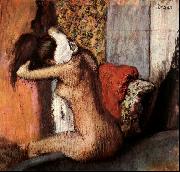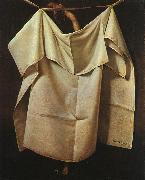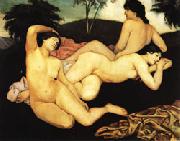
Oil On
Canvas, Real Flavor of Old Masters
|
Edgar Degas
|
|||
|
|
|||
| French Realist/Impressionist Painter and Sculptor, 1834-1917 French painter, draughtsman, printmaker, sculptor, pastellist, photographer and collector. He was a founder-member of the Impressionist group and the leader within it of the Realist tendency. He organized several of the group exhibitions, but after 1886 he showed his works very rarely and largely withdrew from the Parisian art world. As he was sufficiently wealthy, he was not constricted by the need to sell his work, and even his late pieces retain a vigour and a power to shock that is lacking in the contemporary productions of his Impressionist colleagues. | |||
|
|
|||
|
|
After the Bath Edgar Degas60.jpg Painting ID:: 863 Visit European Gallery |
||
Height Width |
INS/CM |
||
|
X |
|
||
|
|
|||
|
Raphaelle Peale
|
|||
|
|
|||
| 1774-1825 Peale was born in Philadelphia as the son and first child of Rachel and Charles Willson Peale, a famous portraitist. Lived in Philadelphia, on a home at the corner of 3rd and Lombard. Married Martha (Patty) McGlathery at the age of 20. First first professional exhibition was in 1795 at the age of 21. Artist. Born Raphaelle Peale in Annapolis, Maryland on February 17, 1774, the fifth child, though eldest surviving, of Charles Willson Peale and his first wife Rachel Brewer. As with all the Peale children, Raphael was trained by his father as an artist. Early in his career, the pair collaborated on portraits. On some commissions, Raphael painted miniatures while his brother, Rembrandt, painted full size portraits. In 1792, he made a trip to South America in order to collect specimens for the Peale's Museum. In 1797, with his brother Rembrandt, he traveled to Charleston, South Carolina, where they attempted to establish another museum. The plan fell through, however, and Raphael returned to painting miniatures. He married Martha McGlathery at about that same time, and with her had eight children. For about two years beginning in 1803, Raphael toured Virginia with the ??physiognotrace,' a profile making machine, with which he was briefly successful. In August 1808, he was hospitalized with delirium tremens, exacerbated by severe gout. By 1813, he was unable to walk without crutches. After the downturn in his health, in an era when most artists considered still life a subject worthy only of amateurs, he devoted himself almost exclusively to still life painting. It is for these works he is best known. Raphael Peale is today considered the founder of the American Still Life school. His work was on frequent exhibit at the Pennsylvania Academy of the Fine Arts between 1814 and 1818. After reportedly indulging in a night of heavy drinking, his health destroyed, Raphael died on March 3, 1825 at age 51 at his home in Philadelphia. Peale's tightly grouped still lifes are often permeated with a delicate melancholy akin to that which characterized the life of the artist; he was an alcoholic who suffered the effects of arsenic and mercury poisoning caused by his work as a taxidermist in his father's museum. His spare, essential style may have been influenced by the Spanish still lifes he studied in Mexico and by the works of Juan Sanchez Cotan, exhibited at the Pennsylvania Academy in 1818. | |||
|
|
|||
|
|
After the Bath Raphaelle Peale1.jpg Painting ID:: 4271 Visit European Gallery |
1823 | |
Height Width |
INS/CM |
||
|
X |
|
||
|
|
|||
|
Emile Bernard
|
|||
|
|
|||
| 1868-1941 French Emile Bernard Galleries (b Lille, 28 April 1868; d Paris, 15 April 1941). French painter and writer. He was the son of a cloth merchant. Relations with his parents were never harmonious, and in 1884, against his fathers wishes, he enrolled as a student at the Atelier Cormon in Paris. There he became a close friend of Louis Anquetin and Toulouse-Lautrec. In suburban views of Asnires, where his parents lived, Bernard experimented with Impressionist and then Pointillist colour theory, in direct opposition to his masters academic teaching; an argument with Fernand Cormon led to his expulsion from the studio in 1886. He made a walking tour of Normandy and Brittany that year, drawn to Gothic architecture and the simplicity of the carved Breton calvaries. In Concarneau he struck up a friendship with Claude-Emile Schuffenecker and met Gauguin briefly in Pont-Aven. During the winter Bernard met van Gogh and frequented the shop of the colour merchant Julien-Franois Tanguy, where he gained access to the little-known work of Cezanne. | |||
|
|
|||
|
|
After the Bath Emile Bernard_2KXrsb.jpg Painting ID:: 11650 Visit European Gallery |
the Nymphs,1908 3' 11 3/4'' x 4' 11 1/2''(121 x 151 cm)Gift of Paul Jamot,1931 | |
Height Width |
INS/CM |
||
|
X |
|
||
|
|
|||
|
Nicolae Grigorescu
|
|||
|
|
|||
| Romanian Painter, 1838-1907 From 1848 he trained in Bucharest with various church painters, producing icons and religious mural decorations. These works, which soon attracted attention, were influenced in style by the Viennese classicism widespread in the Romanian principalities in the early 19th century and by the Italian academicism established there after 1850 by Gheorghe Tattarescu. The earliest of his known paintings are in the church of SS Constantin and Elena at Baicoi, where his signature can be seen beside that of Nita Pereescu on the icon of St George (1853). He subsequently painted a series of icons (1854-5) at Caldarusani Monastery. In the later ensembles he was assisted by his older brother Georghe Grigorescu, who participated under his direction in the decoration of churches, such as those of the Zamfira (1856-8) and Agapia (1858-60) monasteries. In Nicolae's paintings at Agapia, classicism in Romanian art reached its highest point. The royal icons are distinguished for the elegance of the figures, both in their attitudes and in their drapery. | |||
|
|
|||
|
|
After the Bath new4/Nicolae Grigorescu-226856.jpg Painting ID:: 30804 Visit European Gallery |
nn06 oil on canvas 33x38.5cm National Art Museum of Romania, Bucharest | |
Height Width |
INS/CM |
||
|
X |
|
||
|
|
|||










